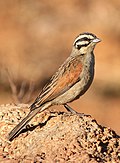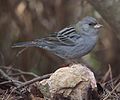Bunting (bird)
| Bunting | |
|---|---|

| |
| Cirl bunting (Emberiza cirlus) | |
| Scientific classification | |
| Domain: | Eukaryota |
| Kingdom: | Animalia |
| Phylum: | Chordata |
| Class: | Aves |
| Order: | Passeriformes |
| Superfamily: | Emberizoidea |
| Family: | Emberizidae Vigors, 1831 |
| Genus: | Emberiza Linnaeus, 1758 |
| Type species | |
| Emberiza citrinella | |
| Species | |
|
44, see text | |
| Synonyms | |
| |
The buntings are a group of Old World passerine birds forming the genus Emberiza, the only genus in the family Emberizidae. The family contains 44 species. They are seed-eating birds with stubby, conical bills.
Taxonomy
The family Emberizidae was formerly much larger and included the species now placed in the Passerellidae (New World sparrows) and Calcariidae (longspurs and snow buntings). Molecular phylogenetic studies found that the large family consisted of distinct clades that were better treated as separate families.[1][2]
The genus Emberiza is now the only genus placed in the family Emberizidae.[3] The genus was introduced by the Swedish naturalist Carl Linnaeus in 1758 in the tenth edition of his Systema Naturae.[4] The type species was subsequently designated as the yellowhammer (Emberiza citrinella).[5] The genus name Emberiza is from Old German Embritz, a bunting.[6] The origin of the English "bunting" is unknown.[7]
A 2008 genetic study found that three emberizid species that were placed in their own monotypic genera clustered within the Emberiza. These were the crested bunting (Melophus lathami), the slaty bunting (Latouchiornis siemsseni), and the corn bunting (Miliaria calandra).[8] All three species are now included in the genus Emberiza.[3]
A large DNA-based study of the passerines published in 2019 found that the buntings are most closely related to the longspurs and snow buntings in the family Calcariidae.[9]
Ornithologists Edward Dickinson and Leslie Christidis in the fourth edition of the Howard and Moore Complete Checklist of the Birds of the World chose to split up Emberiza and recognise the genera Fringillaria, Melophus, Granativora, Emberiza, and Schoeniclus.[10] Their example has not been followed by the online version of the Handbook of the Birds of the World[11] nor by Frank Gill and David Donsker in the list of world birds that they maintain on behalf of the International Ornithologists' Union.[3] The British Ornithologists' Union has argued that splitting the genus provides little benefit and destabilizes the nomenclature.[12]
Species in the New World genus Passerina include the word "bunting" in their common names, but are now classed in the family Cardinalidae.[13]
The family is divided into four major clades. The species in Clade I are mainly African while those in Clades II to IV are Palearctic:[14]
| Emberizidae |
| ||||||||||||||||||||||||||||||||||||||||||||||||||||||||||||||||||||||||||||||||||||||||||||||||||||||||||||||||||||||||||||||||||||||||||||||||||||||||||||||||||||||||||||||||||||||||||||||||||||||||||||||||||||||||||||||||||||||||||||||||||||||
The above cladogram is based on a study published in 2021. The phylogenetic relationships of two African species, the brown-rumped bunting (Emberiza affinis) and Vincent's bunting (Emberiza vincenti), were not determined.[14]
List of species
The genus contains 44 species.[3]
| Image | Common Name | Scientific name | Distribution |
|---|---|---|---|
 |
Crested bunting | Emberiza lathami | Southeast Asia. |
 |
Slaty bunting | Emberiza siemsseni | China. |
 |
Corn bunting | Emberiza calandra | Western Europe and North Africa across to northwestern China. |
 |
Yellowhammer | Emberiza citrinella | southeast England and most of Europe east to the northwestern corner of Russia and western Ukraine. |
 |
Pine bunting | Emberiza leucocephalos | Asia |
 |
Rock bunting | Emberiza cia | northwest Africa, southern Europe east to central Asia, and the Himalayas |
 |
Godlewski's bunting | Emberiza godlewskii | China, Pakistan, India, Kazakhstan, Mongolia, Myanmar, and Russia. |
 |
Meadow bunting | Emberiza cioides | southern Siberia, northern and eastern China, eastern Kazakhstan, Kyrgyzstan, Mongolia, Korea and Japan. |
 |
White-capped bunting | Emberiza stewarti | Afghanistan, India, Iran, Kazakhstan, Kyrgyzstan, Nepal, Pakistan, Tajikistan, Turkmenistan, and Uzbekistan. |
| Jankowski's bunting | Emberiza jankowskii | Russian Far East, Manchuria and far northeastern Korea | |
 |
Grey-necked bunting | Emberiza buchanani | Caspian Sea to the Altai Mountains in Central Asia |
 |
Cinereous bunting | Emberiza cineracea | southern Turkey and southern Iran |
 |
Ortolan bunting | Emberiza hortulana | European countries and western Asia |
 |
Cretzschmar's bunting | Emberiza caesia | Greece, Turkey, Cyprus and the Levant. |
 |
Cirl bunting | Emberiza cirlus | southern Europe, on the Mediterranean islands and in north Africa |
 |
Striolated bunting | Emberiza striolata | Chad, east through south-west Asia to north-western India, Africa |
 |
House bunting | Emberiza sahari | northwestern Africa from Morocco south to Mali and east to Chad. |
 |
Lark-like bunting | Emberiza impetuani | Angola, Botswana, Lesotho, Namibia, South Africa, and Zimbabwe. |
 |
Cinnamon-breasted bunting | Emberiza tahapisi | mainland sub-Saharan Africa |
 |
Gosling's bunting | Emberiza goslingi | Mauritania and Senegal to south-western Sudan and north-eastern Democratic Republic of Congo. |
| Socotra bunting | Emberiza socotrana | Yemen | |
 |
Cape bunting | Emberiza capensis | southern Africa from south-western Angola, eastern Zambia, Zimbabwe and southern Tanzania to the Cape. |
 |
Tristram's bunting | Emberiza tristrami | eastern Manchuria and the Russian Far East and winters in central and southern China. |
 |
Chestnut-eared bunting | Emberiza fucata | the Himalayas locally across China to south-eastern Siberia, Korea and northern Japan |
 |
Little bunting | Emberiza pusilla | north-east of Europe and northern Eurosiberia to the Russian Far East and northern India, southern China and the northern parts of south-east Asia. |
 |
Yellow-browed bunting | Emberiza chrysophrys | eastern Siberia, China |
 |
Rustic bunting | Emberiza rustica | south-east Asia, Japan, Korea, and eastern China. |
 |
Yellow-throated bunting | Emberiza elegans | China, Japan, Korea, Myanmar, Russia, and Taiwan. |
 |
Yellow-breasted bunting | Emberiza aureola | Finland to Bering Sea migrating to Indochina |
 |
Somali bunting | Emberiza poliopleura | Ethiopia, Kenya, Somalia, South Sudan, Tanzania, and Uganda |
 |
Golden-breasted bunting | Emberiza flaviventris | Africa south of the Sahara |
 |
Brown-rumped bunting | Emberiza affinis | Senegal to Sudan and Uganda |
 |
Cabanis's bunting | Emberiza cabanisi | sub-Saharan Africa |
 |
Chestnut bunting | Emberiza rutila | Siberia, northern Mongolia and north-eastern China. |
 |
Tibetan bunting | Emberiza koslowi | Tibet |
 |
Black-headed bunting | Emberiza melanocephala | Japan, China, Hong Kong, Thailand, Laos, South Korea and Malaysia |
 |
Red-headed bunting | Emberiza bruniceps | Asia-Afghanistan, Iran, Kazakhstan, Kyrgyzstan, Mongolia; Russian Federation (European Russia, Central Asian Russia), Tajikistan, Turkmenistan, Uzbekistan. |
 |
Yellow bunting | Emberiza sulphurata | Japan |
 |
Black-faced bunting | Emberiza spodocephala | southern Siberia across to northern China. |
 |
Masked bunting | Emberiza personata | Sakhalin, the Kuril Islands, and Japan. |
 |
Grey bunting | Emberiza variabilis | Kamchatka, Sakhalin, Kuril Islands and northern Japan |
 |
Pallas's reed bunting | Emberiza pallasi | northeast European Russia, north Kamchatka |
 |
Ochre-rumped bunting | Emberiza yessoensis | eastern Mongolia, northeast China and Ussuriland |
 |
Common reed bunting | Emberiza schoeniclus | Europe |
Extinct species have been described:[15]
- † Long-legged bunting (Emberiza alcoveri) (Late Quaternary)
- † Emberiza shaamarica (Late Pliocene of Central Asia)[16]
- † Emberiza polgardiensis (Upper Miocene of Hungary)
- † Emberiza media (Pliocene of Hungary)
- † Emberiza parva (Pliocene of Hungary)
- †Emberiza gaspariskii (Pliocene of Hungary)
- †Emberiza bartoki (Middle Miocene of Hungary) (Nomen dubium) [16]
Emberiza pannonica from the upper Miocene of Hungary is also referred to this genus, but was later found to be a member of Muscicapidae.[16]
References
- ^ Barker, F.K.; Burns, K.J.; Klicka, J.; Lanyon, S.M.; Lovette, I.J. (2013). "Going to extremes: contrasting rates of diversification in a recent radiation of New World passerine birds". Systematic Biology. 62 (2): 298–320. doi:10.1093/sysbio/sys094. PMID 23229025.
- ^ Barker, F.K.; Burns, K.J.; Klicka, J.; Lanyon, S.M.; Lovette, I.J. (2015). "New insights into New World biogeography: An integrated view from the phylogeny of blackbirds, cardinals, sparrows, tanagers, warblers, and allies". Auk. 132 (2): 333–346. doi:10.1642/AUK-14-110.1.
- ^ a b c d Gill, Frank; Donsker, David; Rasmussen, Pamela, eds. (January 2021). "Sylviid babblers, parrotbills, white-eyes". IOC World Bird List Version 12.1. International Ornithologists' Union. Retrieved 22 May 2022.
- ^ Linnaeus, Carl (1758). Systema Naturae per regna tria naturae, secundum classes, ordines, genera, species, cum characteribus, differentiis, synonymis, locis (in Latin). Vol. 1 (10th ed.). Holmiae:Laurentii Salvii. p. 176.
- ^ Paynter, Raymond A. Jr, ed. (1970). Check-list of Birds of the World. Vol. 13. Cambridge, Massachusetts: Museum of Comparative Zoology. p. 5.
- ^ Jobling, James A. (2010). The Helm Dictionary of Scientific Bird Names. London, United Kingdom: Christopher Helm. p. 145. ISBN 978-1-4081-2501-4.
- ^ "Bunting". Oxford English Dictionary (Online ed.). Oxford University Press. (Subscription or participating institution membership required.)
- ^ Alström, P.; Olsson, U.; Lei, F.; Wang, H.; Gao, W.; Sundberg, P. (2008). "Phylogeny and classification of the Old World Emberizini (Aves, Passeriformes)". Molecular Phylogenetics and Evolution. 47 (3): 960–973. Bibcode:2008MolPE..47..960A. doi:10.1016/j.ympev.2007.12.007. PMID 18411062.
- ^ Oliveros, C.H.; et al. (2019). "Earth history and the passerine superradiation". Proceedings of the National Academy of Sciences of the United States of America. 116 (16): 7916–7925. Bibcode:2019PNAS..116.7916O. doi:10.1073/pnas.1813206116. PMC 6475423. PMID 30936315.
- ^ Dickinson, E.C.; Christidis, L., eds. (2014). The Howard & Moore Complete Checklist of the Birds of the World. Vol. 2: Passerines (4th ed.). Eastbourne, UK: Aves Press. pp. 353–357. ISBN 978-0-9568611-2-2.
- ^ del Hoyo, Joseph (ed.). "Taxonomic structure and notes: Emberizidae". Handbook of the Birds of the World Alive. Lynx Edicions. Retrieved 25 June 2019.
- ^ Sangster, G.; et al. (2016). "Taxonomic recommendations for Western Palearctic birds: 11th report". Ibis. 158 (1): 206–212. doi:10.1111/ibi.12322.
- ^ Gill, Frank; Donsker, David, eds. (2019). "Cardinals, grosbeaks and (tanager) allies". World Bird List Version 9.2. International Ornithologists' Union. Retrieved 24 June 2019.
- ^ a b Cai, T.; Wu, G.; Sun, L.; Zhang, Y.; Peng, Z.; Guo, Y.; Liu, X.; Pan, T.; Chang, J.; Sun, Z.; Zhang, B. (2021). "Biogeography and diversification of Old World buntings (Aves: Emberizidae): radiation in open habitats". Journal of Avian Biology. 52 (6). doi:10.1111/jav.02672. S2CID 236608560.
- ^ Rando, J. C.; Lopez, M.; Segui, B. (1999). "A new species of extinct flightless passerine" (PDF). The Condor. 101 (1): 1–13. doi:10.2307/1370440. JSTOR 1370440.
- ^ a b c Palastrova, E.S; Zelenkov, N. (2020). "A Fossil Bunting Emberiza shaamarica (Aves, Emberizidae) from the Upper Pliocene of Central Asia". Paleontological Journal. 54 (6): 96–104. Bibcode:2020PalJ...54..652P. doi:10.1134/S0031030120060076. S2CID 227133794.
Further reading
Buntings and Sparrows – A Guide to the Buntings and North American Sparrows by Urban Olsson and Jon Curson, illustrated by Clive Byers (1995) ISBN 1-873403-19-4
External links
- Bunting videos, photos and sounds on the Internet Bird Collection
- . The American Cyclopædia. 1879.
